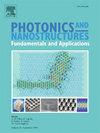Optical fiber localized surface plasmon resonance sensor based on dense gold trisoctahedra
IF 2.9
3区 物理与天体物理
Q3 MATERIALS SCIENCE, MULTIDISCIPLINARY
Photonics and Nanostructures-Fundamentals and Applications
Pub Date : 2025-06-07
DOI:10.1016/j.photonics.2025.101411
引用次数: 0
Abstract
Tuning the plasmonic coupling of noble metal nanoparticles is important for improving the sensitivity and performance of localized surface plasmon resonance (LSPR) sensing. Combining the excellent LSPR performance of gold trisoctahedra (Au TOH) with unique tips, a novel optical fiber LSPR sensor was prepared by uniformly and densely assembling Au TOH on optical fiber using liquid-liquid interface self-assembly method. This method allows for the non-destructive transfer of pre-prepared dense Au TOH monolayer film onto optical fiber in a simple and time-saving manner. The LSPR characteristics of Au TOH on optical fiber with different spacing were simulated by the finite difference time domain (FDTD). Expectedly, the decreasing of the Au TOH spacing can enhance the local electric field strength, and leads to LSPR peak broadening, resonance wavelength redshift, and improving the sensing sensitivity. Meanwhile, the nanoparticle gap of the practically prepared optical fiber LSPR sensor was approximately 5 nm, and such narrow gap ensures the sensitivity of sensor based on the theoretical simulation results. Furthermore, the detection of sucrose solutions with different concentrations was successfully achieved based on the sensor combined with microfluidic technology, with the highest sensitivity up to 200.67 nm/RIU. The remarkable performance and simple preparation strategy make this optical fiber LSPR sensor own excellent potentials for highly sensitive and cost-effective biomedical sensing applications.
基于致密金三八面体的光纤局域表面等离子体共振传感器
调整贵金属纳米粒子的等离子体耦合对于提高局部表面等离子体共振(LSPR)传感的灵敏度和性能具有重要意义。结合尖端独特的金三八面体(Au TOH)优异的LSPR性能,采用液-液界面自组装方法将Au TOH均匀密集组装在光纤上,制备了一种新型光纤LSPR传感器。该方法允许以简单和节省时间的方式将预先制备的致密Au TOH单层膜无损地转移到光纤上。利用时域有限差分法(FDTD)模拟了不同间距光纤上Au - TOH的LSPR特性。预期Au TOH间距的减小可以增强局域电场强度,导致LSPR峰展宽,共振波长红移,提高传感灵敏度。同时,实际制备的光纤LSPR传感器的纳米颗粒间隙约为5 nm,理论仿真结果表明,如此窄的间隙保证了传感器的灵敏度。此外,该传感器结合微流控技术成功实现了不同浓度蔗糖溶液的检测,最高灵敏度可达200.67 nm/RIU。优异的性能和简单的制备策略使该光纤LSPR传感器在高灵敏度和高性价比的生物医学传感应用中具有良好的潜力。
本文章由计算机程序翻译,如有差异,请以英文原文为准。
求助全文
约1分钟内获得全文
求助全文
来源期刊
CiteScore
5.00
自引率
3.70%
发文量
77
审稿时长
62 days
期刊介绍:
This journal establishes a dedicated channel for physicists, material scientists, chemists, engineers and computer scientists who are interested in photonics and nanostructures, and especially in research related to photonic crystals, photonic band gaps and metamaterials. The Journal sheds light on the latest developments in this growing field of science that will see the emergence of faster telecommunications and ultimately computers that use light instead of electrons to connect components.

 求助内容:
求助内容: 应助结果提醒方式:
应助结果提醒方式:


